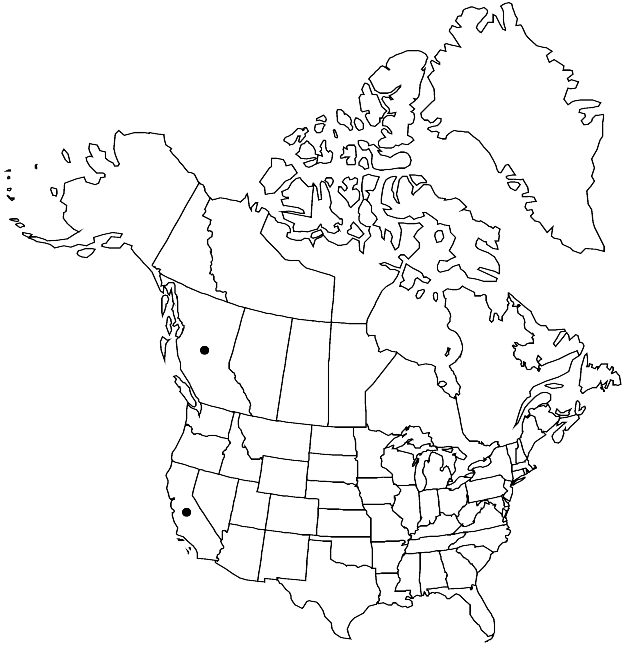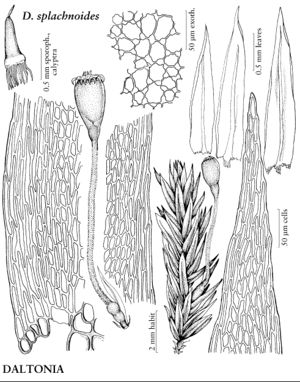Daltonia splachnoides
Muscol. Brit., 80. 1818.
Stems 1(–1.5) cm; cortical cells attached at leaf insertion. Leaves scarcely contorted when dry, linear-lanceolate, carinate as narrow median fold, 1–2.3 × 0.4 mm; margins plane or variably revolute on same stem (throughout one side, partially distally or proximally), border distinct to insertion, cells well defined in 6–8 rows at base, 3 or 4 rows mid leaf, ca. 2 rows in acumen; apex acute (not cuspidate or attenuate); basal laminal cells linear-oblong, 50 µm, pellucid, hyaline, cells across insertion usually vivid, dark red; distal cells ovate, rhomboidal, or narrowly rhomboid-hexagonal, 12(–24) × (6–)7 µm, walls incrassate; juxtacostal cells undifferentiated. Specialized asexual reproduction infrequent, by laminal gemmae, orange, fusiform, multicellular. Seta red to red-brown, 0.6–0.7 cm, papillose-scabrous distally. Capsule red-brown to dark brown, obovoid, neck short, papillose; operculum rostrate. Calyptra slightly roughened distally. Spores (10–)14–16 µm.
Phenology: Capsules mature summer.
Habitat: Base of trees, fallen branches, trunks of shrubs and trees, forests, foggy, hyperoceanic areas
Elevation: low to moderate elevations (0-300 m)
Distribution

B.C., Calif., Mexico, West Indies, Central America, South America, w Europe (Ireland), Asia (China), Atlantic Islands, Pacific Islands (New Zealand), Australia.
Discussion
In the flora area, Daltonia splachnoides is known only from San Francisco County, California, in Cupressus and Eucalyptus forests, in partial shade on fallen branches of Cupressus or trunks of Myoporum laetum or bases of Eucalyptus, and from the Queen Charlotte Islands, British Columbia, first collected by W. B. Schofield on Moresby Island (W. H. Welch 1972). Commonly, D. splachnoides is distinguished by plane leaf margins, but margins are variously partially or completely revolute on one or both sides. The distinction of D. splachnoides from D. gracilis has long been in dispute. P. Majestyk (2011) examined the types of D. gracilis at NY and BM and synonymized the two species, which significantly expanded the distribution of D. splachnoides worldwide. J. Yu et al. (2010) also treated the two species as synonymous. Given that D. splachnoides exemplars group well worldwide, molecular analysis supports the synonymy of the two species, as does the morphological similarity observed.
Selected References
None.
